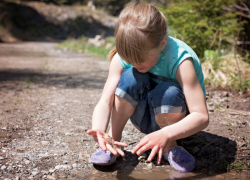Exploring Beyond the Beaten Path!
Nature journal ideas for the summertime!
Browse our list of awesome ideas for how to fill up your very own nature journal with sketches, observations and fun! You can write down some ideas you find here or print the pdfs at home - however you want to keep your nature journal is the right way!
Make your own nature journal. If you got our nature journal kit last month, you're ready to go, but if you missed that Stem Take and Make, don't worry! We've included the instructions so that with a few items, you can make your very own! A small saddle stitched or spiral bound notebook will work just as well.
Creepy Crawly Critters
Summer is a great time to learn about bugs and spiders! There are so many to see in their natural habitat as they go about their daily lives, pollinating, helping plant matter decompose and even keeping insect populations in check (thanks, spiders). So don't squish! Do science!
- Butterfly lifecycle. Did you get to name one of our painted lady caterpillars here at the library? Try drawing out the different stages of a caterpillar's life as if becomes a butterfly!
- Bug Travel Journal. Time to get up close and personal! Find a bug (a crawling one or a pollinator that makes a lot of stops is best) and follow them for five to ten minutes. What stops do they make and why? Keep a travel journal for the bug from their point of view!
- Pill Bug Habitat. Pill bugs, potato bugs or roly polies - whatever name you know them by, they are a fan favorite! And they are actually a little crustacean! You can find them under stumps and rocks or in a wood pile. Use this guide to make a comfy vacation home for a pill bug.
- Bug Walk. Go on a nature walk (this counts as a badge if you are doing your Summer Reading Program on Beanstack this year!) and count the bugs you see. How many of the same type? How many different types?
- Bee Watering Station. Pollinating all those flowers is hard work! Give bees a break with this super fun and easy bee watering station project.
Wild Weather
Summer isn't always all sunshine all the time, but even when it is, there's a lot of natural patterns to observe in the sun, wind and water!
- Cloud Observations. What kinds of different clouds do you see in the summer sky? Try sketching some shapes or recording when you see them and when you don't. Clouds look different when they could be rain clouds versus when they're just wispy and passing by!
- Shadow Tracing. When it's not so cloudy, try observing shadows. Place a small object on your nature journal page and trace its shadow at different times of day.
- Homemade Barometer. This video walks you through the process of creating your very own weather-predicting device! Create your own and learn about air pressure and what it means for weather!
- What Sinks, What Floats? Fill a small clear container with water and record the different densities of items you find in nature. How about items that absorb water? Place things like dirt, leaves and twigs in a muffin tin and fill the cups with water. What absorbs all of it? How about SOME of it?
Terrific Trees and Plants
One of the most crucial parts of our ecosystem are the plants and trees that make it livable! From giving us shade to absorbing CO2 to shedding leaves and twigs that decompose and nourish the soil, plants and trees do so much for us! How can you give back?
- Color Matching and Nature Scavenger Hunt. Use this pdf printable or make your own with colored pencils or crayons, then go out in nature and match the colors and find the items!
- Sock Walk. Wear shoes with a deep tread and put some extra large socks on over them - then just take a walk in your yard! See what sticks! If you find any seeds stuck to your socks, try planting them to see what grows!
- Leaf Rubbing. Place a leaf you find under a page in your journal and rub the other side with the side of a crayon to reveal all the bumps and veins in the leaf!
- Plant Growth Chart. Did you plant one of our Douglas Fir trees in April? If not, try planting a tree or a flower now and measure its growth over the summer.
- Seed Starting. Watch this video to learn how to start seeds from fruits and flowers you have around the house! Record your observations in your nature journal.
We hope this gives you some great ideas for your very own nature journal as you get out and about off the beaten path this summer!

